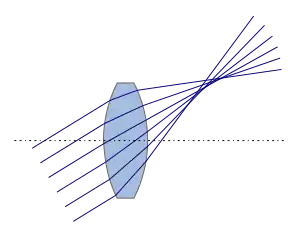
In optics (especially telescopes), the coma (/ˈkoʊmə/), or comatic aberration, in an optical system refers to aberration inherent to certain optical designs or due to imperfection in the lens or other components that results in off-axis point sources such as stars appearing distorted, appearing to have a tail (coma) like a comet. Specifically, coma is defined as a variation in magnification over the entrance pupil. In refractive or diffractive optical systems, especially those imaging a wide spectral range, coma can be a function of wavelength, in which case it is a form of chromatic aberration.
Overview
Coma is an inherent property of telescopes using parabolic mirrors. Unlike a spherical mirror, a bundle of parallel rays parallel to the optical axis will be perfectly focused to a point (the mirror is free of spherical aberration), no matter where they strike the mirror. However, this is only true if the rays are parallel to the axis of the parabola. When the incoming rays strike the mirror at an angle, individual rays are not reflected to the same point. When looking at a point that is not perfectly aligned with the optical axis, some of the incoming light from that point will strike the mirror at an angle. This causes an image that is not in the center of the field to appear as wedge-shaped. The further off-axis (or the greater the angle subtended by the point with the optical axis), the worse this effect is. This causes stars to appear to have a cometary coma, hence the name.
Schemes to reduce coma without introducing spherical aberration include Schmidt, Maksutov, ACF and Ritchey–Chrétien optical systems. Correction lenses, "coma correctors" for Newtonian reflectors have been designed which reduce coma in newtonian telescopes. These work by means of a dual lens system of a plano-convex and a plano-concave lens fitted into an eyepiece adaptor which superficially resembles a Barlow lens.[1][2]
Coma of a single lens or a system of lenses can be minimized (and in some cases eliminated) by choosing the curvature of the lens surfaces to match the application. Lenses in which both spherical aberration and coma are minimized at a single wavelength are called bestform or aplanatic lenses.
In human vision
Vertical coma is the most common higher-order aberration in the eyes of patients with keratoconus.[3] Coma is also a common temporary symptom of corneal injuries or abrasions, in which case the visual defect gradually resolves as the cornea heals.

See also
References
- ↑ a coma-correcting meniscus lens 4571036, Gebelein, Rolin J. & Shafer, David
- ↑ Knisely, David (2004). "Tele Vue Paracor Coma Corrector for Newtonians" (PDF). Cloudy Nights Telescope Review. Retrieved 29 November 2010.
- ↑ Pantanelli S, MacRae S, Jeong TM, Yoon G (November 2007). "Characterizing the wave aberration in eyes with keratoconus or penetrating keratoplasty using a high-dynamic range wavefront sensor". Ophthalmology. 114 (11): 2013–21. doi:10.1016/j.ophtha.2007.01.008. PMID 17553566.